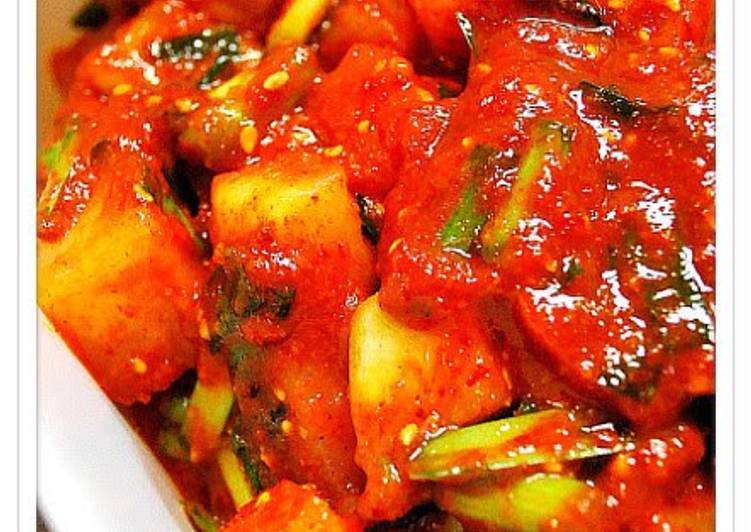It's always a fantastic idea to check out some of the popular Kkakdugi (Cubed Radish Kimchi) recipes which are available on the internet. This will give you a good idea of what it is possible to earn as long as you have some basic knowledge of cooking. The internet also has a great deal of reviews about what you could do and can not do after cooking, so that you may find a clearer idea about what's best to do and what isn't. Provided that you follow a recipe properly, you need to be fine.
Kkakdugi (Cubed Radish Kimchi).

Cooking Tips
If you're sautéing, frying, or grilling, it is essential not to use a little pan. If you would like to earn food melted and slightly browned on the outside, do not use a skillet that is too small since it will cook each of the pieces. A small pan will produce a good deal of steam, causing the dish to burn.
You can cook Kkakdugi (Cubed Radish Kimchi) using 21 ingredients and 19 steps. Here is how you achieve that.
Ingredients of Kkakdugi (Cubed Radish Kimchi)
- You need of Daikon radish.
- Prepare of Salt.
- It's of ★ Small dried sardines (niboshi).
- You need of pieces ★ Kombu.
- Prepare of ★ Water.
- Prepare of ▼ Rice.
- Prepare of ▼ Dashi soup stock.
- You need of ◆ Onions.
- Prepare of ◆ Garlic.
- You need of ◆ Ginger.
- Prepare of ◆ Korean red chili peppers (red).
- You need of ◆ Japanese plum extract.
- You need of ◆ Sardine extract.
- You need of ◆ Fermented krill.
- You need of ◎ Korean red chili powder (for kimchi).
- You need of ◎ Red chili powder (seasoning).
- Prepare of ☆ Green onions.
- It's of ☆ Chinese chives.
- Prepare of Sugar.
- Prepare of Salt.
- It's of Toasted sesame seeds.
Kkakdugi (Cubed Radish Kimchi) instructions
- Thoroughly rinse the daikon radish, and peel the skin with a peeler. Set aside the stalk end and root end. Do not discard..
- Chop the daikon radish into 2 cm rounds, dice them into 2 cm square cubes, then place them in a large bowl. Set aside the triangular shaped pieces..
- While chopping the daikon into cubes, place the ★ ingredients, the triangular shaped daikon pieces and the root end into a large pot with water to prepare the broth..
- Thoroughly rinse the stalk end, and cut the undamaged leaves into 2 cm lengths..
- Combine the cubed daikon and the leaves, add salt, lightly toss, and let sit for 1 hour. Do not rub the salt in..
- After 30 minutes, gently toss to evenly distribute the salt. Do not rub the salt in..
- Turn on the heat under the pot from Step 3, reduce it to medium-low heat after bringing it to a boil, then simmer for 30 minutes to make the broth. Do not let it boil..
- After about 1 hour, thoroughly drain the daikon and leaves from Step 6..
- After the broth is finished, prepare the yangnyeom. Put the rice in a bowl, pour in the hot broth, then process with a hand mixer..
- Process the rice and broth from Step 9 into a thick paste-like porridge, and transfer it to a large bowl..
- Prepare the ◆ ingredients to add to the porridge from Step 10. Remove the seeds from the red chili peppers, then roughly chop them with the onion, garlic, and ginger to make them easy to process, then add them to the porridge..
- Pulse the porridge with the added ingredients, check to make sure that the red chili peppers are finely processed, then turn off the mixer..
- You should be able to buy the Japanese plum extract at a Korean specialty shop. You could also substitute it with sweet syrup or a mild honey, but you will need to adjust the amount of sugar that you add..
- Add the plum extract to the porridge from Step 12, mix well, let it sit for 10 minutes, then stir again. Then the yangnyeom is ready..
- Place the daikon and leaves from Step 8 into a bowl, chop the ☆ ingredients into 2 cm lengths, add them with 250 g of the yangnyeom from Step 14, and evenly combine..
- Gradually mix in the sugar and the salt, and season to taste..
- Add the toasted sesame seeds and mix..
- It's done! Enjoy the three distinct flavors of freshly pickled kkakdugi, marinated kkakdugi, and sweetly acidic kkakdugi.
- Store it in a Tupperware container with a lid, let it sit for a day at room temperature, then store it in the refrigerator from the next day onwards..
If you locate this Kkakdugi (Cubed Radish Kimchi) recipe useful absorb part it to your contacts or family, thank you and fine luck.